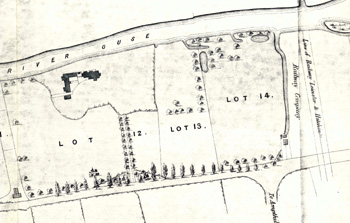Cauldwell Priory Bedford

Cauldwell Priory in 1857
The date of foundation of Caldwell Priory is not known for certain. Its earliest charters endowing the house belong to the reign on Henry II (1154-1189) and it is known that a Prior of Caldwell witnessed a charter granted by Robert Bruce of Scotland to Harrold during the lifetime of King Malcolm IV of Scotland (1153-1165). So the date seems to be between 1154 and 1165. It is not known who founded the priory, though a close roll of Edward III (1327-1377) spoke of the ancestors of Simon Barescote of Bedford [see below].
The priory began as a house of the Order of the Holy Sepulchre and was dedicated to Saint John the Baptist. This order followed the Rule of Saint Augustine and differed from the Augustinians only in name and a red badge worn on their habit. Friars went about the countryside preaching, as opposed to monks, who remained within their cloister praying, copying manuscripts and engaging in other contemplative tasks. The priory was endowed with the advowson of four Bedfordshire churches at the beginning of the 13th century – Bromham, Roxton, Sandy and Oakley as well as the chapel of Clapham. Before 1291 the advowsons of Marsworth and Broughton [Buckinghamshire] and Arnesby [Leicestershire] were added as endowments. Tolleshunt Major [Essex] was added at a later date.
A close roll of Henry III (1215-1272) notes that the priory assisted the royal forces during the siege of Bedford Castle by providing ammunition for the siege engines. In return they got some of the stone from the demolished walls of the castle. When Robert Grosseteste was Bishop of Lincoln the prior of Caldwell. Eudo, was so frightened of a visitation by him in 1249 that he fled to another order and was replaced by the sub-prior of Dunstable Priory, Walter of Caddington.
In 1339 the priory’s lands were seized by a tax official of the Crown because of a rumour that in the 13th century the lands had been taken over by the King and because the prior held two carucates of land in Bedford in fee farm from the king. The priory appealed to the king, however, and Edward III called his official off saying that he had heard that the ancestors of Simon de Barescote had founded the priory and given its advowson to one Robert Marshal, whose descendant Robert de Ufford still held it. The priory’s endowments were not particularly wealthy, consequently the priory itself was never very big, rich, or important, in contrast to Newnham Priory. In 1318 the advowson of Broughton was given to Lincoln Cathedral, with Sandy being given away in 1525. In the same year the Bishop referred to Caldwell as “a very poor place” which could raise only a fifth of the hundred pounds wanted by Henry VIII (1509-1547) as a loan, which he was demanding of all the religious houses in England. The priory was dissolved in 1536 when its income was £109/8/5 and its incumbents a prior and six canons. It later became a substantial residence
The priory buildings stood between the present day Kempston Road and the river. The site later became the western part of the Britannia Iron and Steel site and is today being developed with modern housing.